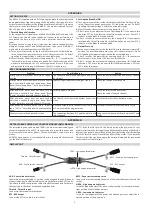
33
i.
Towing and winching
When towing or winching, the glider must be above the pilots head before starting.
In the initial phase the tension should not be too high – a pilot climbing at a flatter angle has
more control.
Tension of more than 90kp is not allowed. In any situation, the maximum permitted tension on
the line must not exceed the pilot’s weight.
The pilot must be informed and aware of the national requirements for towing. This includes
matter such as; tow/winch licence requirements, qualified tow operators, suitability of glider
for towing, if winch and towing-links are certified etc.
In general, the regulated and enforced regulations must to be followed.
j.
Asymmetric and frontal collapses
As with any paraglider collapses can occur. “Active flying” as described in point “f” can help
avoid deformations.
You should always maintain course and direction by weight-shifting away from the collapsed
side. This can be reinforced by pulling the brake on the opposite side to the deflation. If the
collapse stays in, the glider can be re-inflated by pumping the brake on the collapsed side in a
firm and smooth manner. Be aware that the brake travel is shorter when the glider is collapsed
and the glider can stall with less brake input.
To assist in the reopening of a frontal collapse the pilot should pull both brakes equally at the
same time. This also reduces the dive after the glider reopens.
Should a collapse happen with trims open then the reopening is slower.
NOTE
: Pulling too much brake during a frontal collapse recovery can stall the glider or cause
the glider to revert from the frontal collapse directly into a deep-stall.
k.
Reopening a cravat
In extreme conditions it is possible that the wing tip(s) can become trapped between the lines.
In general, this would happen only after a big uncontrolled collapse or during extreme
manoeuvres.
If this cravat occurs, in the first instance use the techniques described for releasing asymmetric
collapses.
If it fails to release, take hold of the stabilo line and pull hard towards yourself until the
trapped section of the wing is released.
At low altitude it is important to stabilise the rotation, if any, and if necessary use the reserve
(rescue) if this is not possible.
l.
Negative Spin
We recommend that this manoeuvre is only carried out during a safety training course over
water and under supervision. The intention in this situation is for a pilot to discover the point-
of-spin and to control it. This demands a high level of experience and skill.
The longer the time between the glider entering a spin and the pilot attempting to recover, the
more risk there is of it getting out of control.
As the glider surges forward, slow it down with the brakes to avoid the possibility of an
Summary of Contents for RIDE 2
Page 2: ...1...
Page 4: ...3...
Page 22: ...21...
Page 43: ...42 A ANHANG ANNEX a bersichtszeichnung Overview...
Page 44: ...43 b Leinenplan line plan...
Page 45: ...44...
Page 46: ...45 c Leinenl ngen Line Length...
Page 47: ...46...
Page 48: ...47...
Page 52: ...51 Korrekte Verbindung zum Tragegurt Correct connection to riser...
Page 55: ...54 C EBL DDP...
Page 60: ......














































